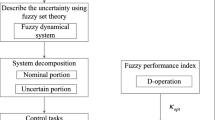Abstract
Motion control for an uncertain swarm robot system consisting of N robots is considered. The robots interact with each other through attractions and repulsions, which mimic some biological swarm systems. The uncertainty in the system is possibly fast time varying and bounded with unknown bound, which is assumed to be within a prescribed fuzzy set. On this premise, an adaptive robust control is proposed. Based on the proposed control, an optimal design problem under the fuzzy description of the uncertainty is formulated. This optimal problem is proven to be tractable, and the solution is unique. The solution to this optimal problem is expressed in the closed form. The performance of the resulting control is twofold. First, it assures the swarm robot system deterministic performances (uniform boundedness and uniform ultimate boundedness) regardless of the actual value of the uncertainty. Second, the minimization of a fuzzy-based performance index is assured. Therefore, the optimal design problem of the adaptive robust control for fuzzy swarm robot systems is completely solved.










Similar content being viewed by others
References
Okubo, A.: Dynamical aspects of animal grouping: swarms, schools, flocks, and herds. Adv. Biophys. 22(2), 1–94 (1986)
Mogilner, A., Edelstein-Keshet, L., Bent, L., Spiros, A.: Mutual interactions, potentials, and individual distance in a social aggregation. J. Math. Biol. 47(4), 353–389 (2003)
Antonelli, G., Chiaverini, S.: Kinematic control of platoons of autonomous vehicles. IEEE Trans. Robot. 22(6), 1285–1292 (2006)
Gazi, V., Passino, K.M.: A class of attractions/repulsion functions for stable swarm aggregations. Int. J. Control 77(18), 1567–1579 (2004)
Parrish, J.K., Viscido, S.V., Grünbaum, D.: Self-organized fish schools: an examination of emergent properties. Biol. Bull. 202(3), 296–305 (2002)
Dimarogonas, D.V., Kyriakopoulos, K.J.: Connectedness preserving distributed swarm aggregation for multiple kinematic robots. IEEE Trans. Robot. 24(5), 1213–1223 (2008)
Gazi, V.: Swarm aggregations using artificial potentials and sliding-mode control. IEEE Trans. Robot. 21(6), 1208–1214 (2005)
Chen, Y.H.: Artificial swarm system: boundedness, convergence, and control. J. Aerosp. Eng. 21(4), 288–293 (2008)
Ranjbar-Sahraei, B., Shabaninia, F., Nemati, A., Stan, S.D.: A novel robust decentralized adaptive fuzzy control for swarm formation of multiagent systems. IEEE Trans. Ind. Electron. 59(8), 3124–3134 (2012)
Gazi, V., Fidan, B., Marques, L., Ordonez, R.: Robot swarms: Dynamics and control. In: Kececi, E.F., Ceccarelli, M. (eds.) Mobile robots for dynamic environments, pp. 79–107. ASME, New York (2015)
Zhao, X., Chen, Y.H., Zhao, H.: Control design based on dead-zone and leakage adaptive laws for artificial swarm mechanical systems. Int. J. Control 90(5), 1077–1089 (2016)
Rosenberg, R.M.: Analytical Dynamics of Discrete Systems. Olenum Press, New York (1977)
Chen, Y.H.: Second-order constraints for equations of motion of constrained systems. IEEE/ASME Trans. Mechatron. 3(3), 240–248 (1998)
Udwadia, F.E., Kalaba, R.E.: Analytical Dynamics: A New Approach. Cambridge University Press, Cambridge (2007)
Udwadia, F.E., Wanichanon, T., Cho, H.: Methodology for satellite formation-keeping in the presence of system uncertainties. J. Guid. Control Dyn. 37(5), 1611–1624 (2014)
Udwadia, F.E.: A new approach to stable optimal control of complex nonlinear dynamical systems. J. Appl. Mech. 81(3), 031001 (2014)
Zhao, R., Chen, Y.H., Jiao, S.: Optimal robust control for constrained fuzzy dynamic systems: semi-infinite case. Int. J. Fuzzy Syst. 18(4), 557–569 (2016)
Chen, Y.H., Leitmann, G.: Robustness of uncertain systems in the absence of matching conditions. Int. J. Control 45(5), 1527–1542 (1987)
Corless, M., Leitmann, G.: Continuous state feedback guaranteeing uniform ultimate boundedness for uncertain dynamic systems. IEEE Trans. Autom. Control 26(5), 1139–1144 (1981)
Hale, J.K.: Ordinary Differential Equation. Wiley, New York (1969)
Chen, Y.H.: Performance analysis of controlled uncertain systems. Dyn. Control 6(2), 131–142 (1996)
Klir, G., Yuan, B.: Fuzzy Sets and Fuzzy Logic: Theory and Applications. Prentice-Hall, Englewood Cliffs (1995)
Acknowledgements
The authors wish to thank the referees for their helpful comments and suggestions.
Funding
The research is supported by National Natural Science Foundation of China (Grant No. 51705116), Science and Technology Major Project of Anhui (Grant No. 17030901036) and Fundamental Research Funds for the Central Universities (Grant Nos. JZ2018HGBZ0096/JZ2018HGTA0217/JZ2018HGTB0261).
Author information
Authors and Affiliations
Corresponding author
Appendix
Appendix
We outline the fuzzy mathematics.
Membership function A function that the values assigned to the elements of the universal set fall within a specified range and indicate the membership grade of these elements in the set in question, is called membership function [22].
Fuzzy set A set \(\varOmega\) on the universe of discourse set X is a fuzzy set if the elements of set A are mapped into real numbers in [0, 1] by the membership function \(\mu _\varOmega : X\rightarrow [0,1].\)
\(\alpha\)-cut and strong\(\alpha\)-cut For a given fuzzy set \(\varOmega\) defined on X and any number \(\alpha \in [0,1]\), the \(\alpha\)-cut of fuzzy set \(\varOmega\) is defined as \({{}^{\alpha }}{\varOmega }=\{x \mid \mu _{\varOmega }(x)\ge \alpha \}\), and the strong \(\alpha\)-cut of fuzzy set \(\varOmega\) is defined as \({{}^{\alpha +}}{\varOmega }=\{x \mid \mu _{\varOmega }(x)> \alpha \}.\)
Fuzzy numbers To qualify as a fuzzy number, a fuzzy set \(\varOmega\) must possess the following properties: (i) \(\varOmega\) is a normal fuzzy set; (ii) \(\varOmega\) is convex; (iii) the support of \(\varOmega\) must be bounded; (iv) for each \(\alpha \in (0, 1]\), \({{}^{\alpha }}{\varOmega }\) is a closed interval in \(\mathbf{R}\).
Fuzzy arithmetic Let \(\varOmega _1\), \(\varOmega _2\) denote two fuzzy numbers, and \({{}^{\alpha }}{\varOmega _{1}}=[a_1, b_1]\), \({{}^{\alpha }}{\varOmega _{2}}=[a_2, b_2]\), \(a_1<b_1\), \(a_2<b_2\). Then, the fuzzy arithmetic is provided as follows:
Decomposition theorem The fuzzy set \(\varTheta\) can be decomposed as
where \(\cup\) is the union of the fuzzy sets (i.e., sup over \(\alpha \in [0,1]\)), \({\tilde{\varTheta }}_{\alpha }\) is a special fuzzy set on the universe set X defined by the membership function \(\mu _{{\tilde{\varTheta }}_{\alpha }} = \alpha I(x)\), the function I(x) is defined as
Rights and permissions
About this article
Cite this article
Dong, F., Chen, YH. & Zhao, X. Optimal Design of Adaptive Robust Control for Fuzzy Swarm Robot Systems. Int. J. Fuzzy Syst. 21, 1059–1072 (2019). https://doi.org/10.1007/s40815-019-00626-w
Received:
Revised:
Accepted:
Published:
Issue Date:
DOI: https://doi.org/10.1007/s40815-019-00626-w




